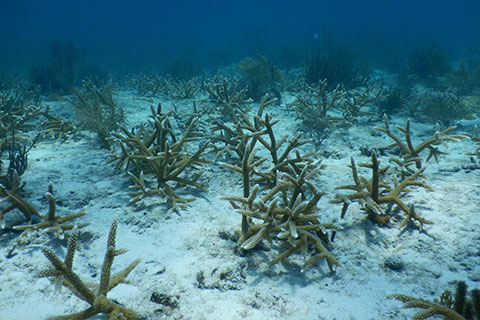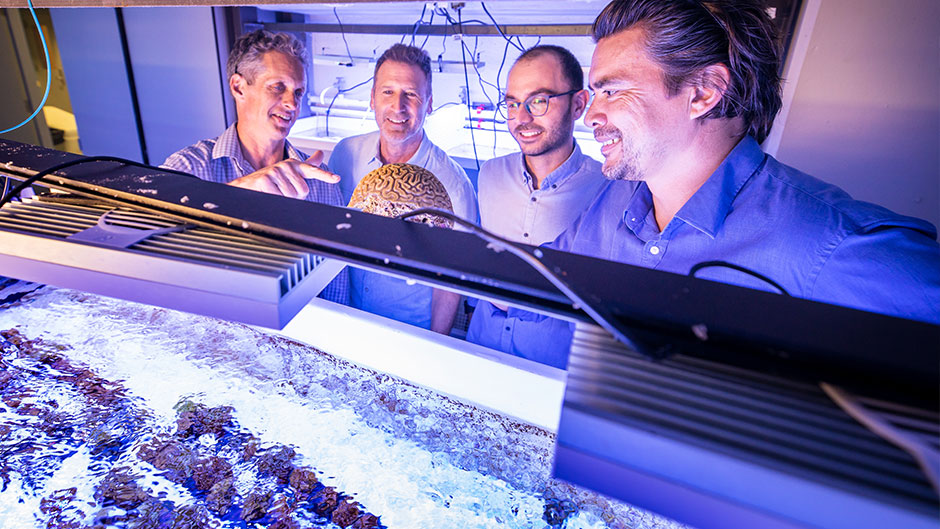Four University of Miami professors are spearheading an effort to restore 125 acres of coral reef habitat off the coast of Miami-Dade and Broward counties to protect Florida’s coastline from further decay.
Professors Diego Lirman, Andrew Baker and Brian Haus from the Rosenstiel School of Marine and Atmospheric Science, along with professor Landolf Rhode-Barbarigos from the College of Engineering recently received a $3 million grant from the National Fish and Wildlife Foundation’s coastal resilience fund. The University, along with numerous local, state and corporate partners, are matching the funding, for a total of $6 million devoted to the project.
“Healthy reefs provide a long list of services including tourism revenue, sand for our beaches, a fishery habitat and a first line of defense for our shorelines against waves, storms, and flooding,” said Diego Lirman, associate professor of Marine Ecology and Biology, who leads the Rescue a Reef conservation program and the Benthic Ecology and Coral Restoration lab at the Rosenstiel School. “Sustaining these beautiful ecosystems is an incredibly important venture for South Florida’s future.”
Propelled by the grant, the newly-formed Southeast Florida Coral Reef Restoration Hub will spend the next three years focused on growing and planting 150,000 larvae, juvenile, and adult coral colonies on reefs that have fallen victim to disease, storms and fluctuating temperatures. Five different species of coral will be restored, with researchers focused on increasing the corals’ heat resistance, so that they can withstand the effects of climate change.
“Testing these innovative approaches to coral restoration puts Florida at the leading edge of global efforts to develop interventions to increase the resilience of coral reefs to climate change,” said Baker, an associate professor in the Rosenstiel School’s Department of Marine Biology and Ecology. “It’s time to try these approaches now to help us buy time for reefs as oceans continue to warm over the coming decades.”
Researchers will also use cutting-edge techniques to save diseased corals. At the same time, they are also working to quantify how coral reefs, and artificial reef structures can help dissipate destructive wave energy that accompanies major storms.


Florida is the only state in the continental U.S. that is home to an extensive barrier reef just off its coast. The state’s coral reefs stretch about 360 miles from the Dry Tortugas off Key West north to the St. Lucie Inlet. Reefs provide a thriving ecosystem for marine life, yet in the past 30 years there has been a steady decline in coral populations, with at least two-thirds of Florida’s coral cover lost due to local pollution, disease and warming ocean temperatures, Baker and Lirman said. Recent events such as coral bleaching in 2014 and 2015, Hurricane Irma in 2017, and stony coral tissue loss disease, which has been decimating Florida’s reefs for the last five years, has amplified the problem, researchers said.
“This is the first large-scale, interdisciplinary program funded to restore Florida’s coral reefs outside of the Florida Keys,” Lirman said. “Hopefully, as these new corals enter the Florida Reef Tract, then reproduce and spawn, we will be able to extend the recovery footprint far beyond the initial restoration planting.”
Currently, there are more than 50 different species of coral found in Florida, yet seven species are considered threatened under the Endangered Species Act. To prevent more coral species from being added to the list, the UM team is working with coral reef experts across the state on different aspects of the effort.
First, to contain the spread of disease and salvage diseased corals, the team will be utilizing a cutting-edge ‘fire break’ technique developed by researcher Brian Walker from Nova Southeastern University. The method includes covering the corals with a putty-like substance and injecting antibiotics to stop the spread of disease.
Then, to rejuvenate and restore existing reefs, the team will be planting thousands of new corals grown at UM and Nova’s coral nurseries, as well as at the Florida Aquarium in Tampa and by the coral reef conservation organization, SECORE International, Lirman said. In addition, the team will be working with researchers from the Frost Science Museum to release sea urchins grown at the Florida Aquarium to help remove the algae that often smother corals, Lirman added.
But since it will take time for the newly planted corals to grow, Haus and Rhode-Barbarigos are simultaneously exploring structural solutions for coral reefs that can moderate the wave energy coming to South Florida’s shores. This is particularly devastating during severe storms like hurricanes, but are an even more menacing threat when coupled with sea level rise.
“Corals will provide physical protection as they grow, but that takes time, so if we want to use corals to protect our shores, we have to have a hybrid approach that combines a manmade structure that can be populated with corals,” Rhode-Barbarigos said. “Flooding and waves are a very important issue exacerbated by climate change and we want to find a solution that is sustainable.”
Quantifying how much coral reefs, and their hybrid stand-ins, can protect the coastline of the Sunshine State is the focus of a University Laboratory for Integrative Knowledge (U-LINK) project the four UM researchers began together in 2017. Haus, a coastal engineer who is professor and chair of the ocean sciences department, directs the massive Alfred C. Glassell, Jr. SUSTAIN wind-wave tank at Rosenstiel and said that researchers have not yet been able to measure the benefits of reefs. However, using the SUSTAIN tank, they are now able to see the role corals play in reducing wave energy during simulated storm conditions.
“So far, there are some conditions where you can get 30 percent additional wave dissipation just with the addition of corals,” Haus said.
They are now in the midst of testing three different structures that may mimic the benefits of coral reefs – reef balls, submerged concrete breakwater structures and a novel modular system based on large perforated hexagonal tubes called SEAHIVE — both in the SUSTAIN tank and soon, off the coast of Miami Beach.
“We’re looking for a good design, that is environmentally-friendly and biocompatible for coral reefs to grow on, but that at the same time can be used to reduce the wave energy coming onshore,” said Rhode-Barbarigos.

